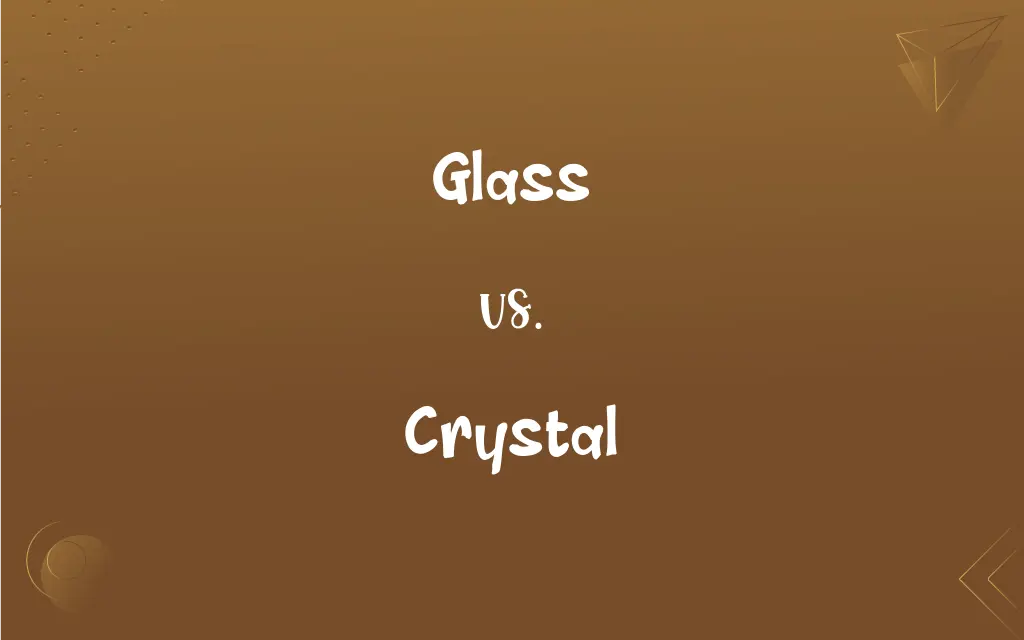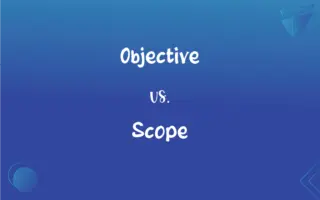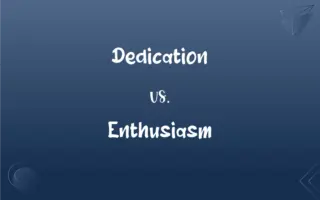Glass vs. Crystal: What's the Difference?
Edited by Harlon Moss || By Janet White || Published on December 7, 2023
Glass is a hard, typically transparent material made from silica, while crystal is a type of glass with added lead oxide for increased clarity and weight.

Key Differences
Glass is a versatile material made by heating a mixture of silica (sand), soda, and lime. It is commonly used in windows, bottles, and a variety of household items. While, crystal, specifically lead crystal, is a type of glass that includes lead oxide, enhancing its weight and the way it refracts light.
The manufacturing process for glass involves melting its components at high temperatures and then molding or blowing it into desired shapes. However, crystal requires a similar process but with the added complexity of incorporating lead oxide, which requires careful handling and specific proportions.
In terms of properties, glass is generally lighter and less refractive compared to crystal. Meanwhile, crystal is known for its brilliance and clarity, often used in high-quality glassware and decorative items due to its ability to refract light more effectively.
Glass is typically more durable and less expensive than crystal, making it suitable for everyday use. Whereas, crystal is often more expensive and less durable, but its aesthetic qualities make it preferred for luxury items and special occasions.
The environmental impact of producing glass is lower compared to that of crystal. The production of crystal, especially lead crystal, can have greater environmental and health implications due to the use of lead.
ADVERTISEMENT
Comparison Chart
Composition
Silica, soda, lime.
Silica, lead oxide, other additives.
Manufacturing
Melted and molded/blown.
Similar, but includes lead oxide.
Properties
Lighter, less refractive.
Heavier, more clarity, higher refraction.
Usage
Everyday items, windows.
Luxury glassware, decorative items.
Environmental Impact
Relatively lower.
Higher, especially for lead crystal.
ADVERTISEMENT
Glass and Crystal Definitions
Glass
Fragile, breakable material.
Be careful with the glass vase, it's fragile.
Crystal
Lead glass.
The crystal vase shimmered under the light.
Glass
Transparent material.
The glass window provided a clear view of the garden.
Crystal
High-quality glassware.
They reserved the crystal glasses for special occasions.
Glass
Lens material.
Her glasses had thick glass lenses for better vision.
Crystal
Refractive decorative item.
The crystal chandelier added elegance to the room.
Glass
Insulating material.
Glass wool is used for thermal insulation.
Crystal
Clear, sparkling glass.
The crystal sculpture was the centerpiece of the exhibit.
Glass
Container made from silica.
He drank water from a glass bottle.
Crystal
Luxury material.
Her necklace had a beautiful crystal pendant.
Glass
Any of a large class of materials with highly variable mechanical and optical properties that solidify from the molten state without crystallization, are typically made by silicates fusing with boric oxide, aluminum oxide, or phosphorus pentoxide, are generally hard, brittle, and transparent or translucent, and are considered to be supercooled liquids rather than true solids.
Crystal
A homogenous solid formed by a repeating, three-dimensional pattern of atoms, ions, or molecules and having fixed distances between constituent parts.
Glass
A drinking vessel.
Crystal
The unit cell of such a pattern.
FAQs
Is glass a solid or liquid?
Glass is an amorphous solid, which means it has a solid structure but a disordered arrangement of molecules.
What is glass?
Glass is a hard, brittle substance typically made by melting silica (sand), soda, and lime.
What are the different types of glass?
Types include float glass, tempered glass, laminated glass, and colored glass, among others.
Can glass be recycled?
Yes, glass can be recycled multiple times without losing purity or quality.
How is glass made?
Glass is made by melting a mixture of silica, soda, and lime at high temperatures, then cooling it rapidly.
Is glass transparent?
Glass is typically transparent, but it can be modified to be translucent or opaque.
What is crystal in terms of materials?
Crystal refers to materials with a highly ordered arrangement of atoms, ions, or molecules, often used for decorative glassware.
Is crystal glass more expensive than regular glass?
Generally, yes. The materials and process of making crystal glass often make it more expensive.
How is colored glass made?
Colored glass is made by adding metallic salts or oxides to the glass mixture during production.
Can glass be molded?
Yes, when heated to a certain temperature, glass becomes malleable and can be molded into various shapes.
What is safety glass?
Safety glass is designed to break into less harmful pieces and includes types like tempered and laminated glass.
Why does glass break easily?
Glass breaks easily due to its brittle nature, which means it has minimal ability to withstand stress before fracturing.
What distinguishes crystal from regular glass?
Crystal is typically heavier, more reflective, and has a higher refractive index than regular glass due to the addition of metal oxides.
How is crystal glass made?
Crystal glass is made by adding lead oxide or other metal oxides to glass, increasing its refractive index.
Can crystal be recycled like glass?
Crystal can be recycled, but not as easily as regular glass due to its different chemical composition.
What are the uses of crystal?
Crystal is commonly used for fine glassware, ornaments, and chandeliers.
Does crystal glass require special care?
Yes, it often requires careful handling and hand washing to maintain its clarity and brilliance.
Is crystal glass safe for everyday use?
It is generally safe, but lead crystal should be used cautiously, especially with acidic drinks.
How can you identify crystal glass?
Crystal glass often has a more brilliant luster, a heavier feel, and a distinct ringing sound when tapped.
Can crystal glass be cut or engraved?
Yes, crystal glass can be expertly cut or engraved, which is often done for decorative purposes.
About Author
Written by
Janet WhiteJanet White has been an esteemed writer and blogger for Difference Wiki. Holding a Master's degree in Science and Medical Journalism from the prestigious Boston University, she has consistently demonstrated her expertise and passion for her field. When she's not immersed in her work, Janet relishes her time exercising, delving into a good book, and cherishing moments with friends and family.
Edited by
Harlon MossHarlon is a seasoned quality moderator and accomplished content writer for Difference Wiki. An alumnus of the prestigious University of California, he earned his degree in Computer Science. Leveraging his academic background, Harlon brings a meticulous and informed perspective to his work, ensuring content accuracy and excellence.







































































